













|
 |
 |
 |
| Bald Eagle Populations in the Great Lakes Region
Back from the Brink |
Who could forget the awesome sight of a Bald Eagle soaring high on an updraft, broad wings silhouetted against the sky? Or the piercing cry as an eagle plummets towards a lake, talons extended to seize unsuspecting prey? | 
|
|
| This Great Lakes Fact Sheet is available in PDF format. |
|
|
The dramatic colouring, beauty in flight, and hunting proficiency of these distinctive birds make them instantly recognizable throughout North America. For many people, they are potent symbols of pride and strength. That connection is a driving force for countless conservationists who have worked hard and successfully to protect and restore Bald Eagle populations in the Great Lakes region.
Bald Eagles were once a common sight in the skies throughout North America, including the Great Lakes shorelines. Since the 1500s, however, habitat loss and persecution seriously depleted Bald Eagle populations. In the early decades of the last century, wildlife conservationists alerted American authorities to the possibility of extinction for this species. The government responded by passing the United States Bald Eagle Act of 1940, which reduced direct killing of the birds and helped to slow the population downturn.
Since then, some regions maintained excellent habitat, supporting local, healthy breeding populations. Bald Eagles thrive along the coastlines of British Columbia and Alaska, and throughout the boreal forests of northern Manitoba, Saskatchewan and Alberta. But heavy development in other areas, such as the Great Lakes, has diminished eagle nesting habitat and foraging opportunities.
|
|
Bald Eagles were in danger of disappearing completely from the Great Lakes region. In the early 1900s, an estimated 200 pairs nested in southern Ontario, from the Ottawa River to the lower Great Lakes. Some 50 pairs were said to nest on the shores of Lake Erie alone. By the late 1970s, eagle pairs nesting on Lake Erie’s shorelines produced no young. Three active pairs were noted on Lake Superior, but they did not reproduce. The situation was equally dire on Lake Ontario, Lake Michigan, Lake Huron, Lake St. Clair, and along the St. Lawrence River.
The birds, it was discovered, were suffering from exposure to a silent killer: pesticides. The most infamous, DDT, or dichlorodiphenyltrichloroethane, was sprayed regularly along wetlands, shorelines and in agricultural areas, from the late 1940s to the 1970s. The toxic residue left behind interfered with the eagles’ ability to reproduce – with devastating consequences.
From the early 1980s, coincident with a significant reduction in the use of toxic chemicals around the Great Lakes, the eagles’ natural reproduction rates began to climb. Concurrently, private organizations and government agencies developed conservation programs to protect nesting sites and to re-establish adequate breeding populations. Volunteers and landowners provided critical assistance to these programs over subsequent years, primarily by monitoring nest sites to determine their level of activity and reproductive status.
Today, Great Lakes Bald Eagles are recovering slowly. Across southern Ontario in 2000, 28 eaglets were known to fledge, or successfully develop to the point of leaving the nest, from 18 of 23 active nests. Finally, the outlook is positive for these magnificent hunters.
There is more work to do to ensure that the Bald Eagle population is a healthy and viable one. Typically, less than half of eaglets hatched reach maturity, and survival rates may dip as low as 10 per cent. Bald Eagles normally produce two or three eggs and fledge one or two chicks. One chick per active nest is adequate to sustain the population, yet each bird potentially faces many obstacles on the way to maturity. Challenges include harsh weather, poor food supplies, persistent (non-biodegrading) contaminants in the environment, and human-caused deaths.
|
|
|
|

 Bald Eagle Facts On the Fly Bald Eagle Facts On the Fly

|
|
There are 59 species of eagles in the world, two of which inhabit North America: the Bald Eagle and the larger Golden Eagle.
Bald Eagles are found exclusively in North America. In Canada, the majority occur along the coast of British Columbia, with smaller populations located across the nation, such as in southern Ontario and New Brunswick .
The scientific name for this powerful predator is Haliaeetus leucocephalus. (Haliaeetus means “sea eagle” and leucocephalus means “white head”.) Adult females are generally larger than the males, and both have the same characteristic plumage. The juvenile birds are a mixture of brown and white until they reach four or five years of age. At maturity, between four and eight years of age, the birds have dark brown feathers on their bodies and wings, snow-white feathers on their heads and tails, and yellow legs, eyes and beaks. As singular as their appearance, the eagles’ call is a haunting series of high-pitched cries, similar to a gull’s call but delivered more quickly and with more apparent urgency.
|
|
Mature Bald Eagles reach an average weight of three to six kilograms. Their wings are broad and may extend to more than two metres, enabling them to soar on columns of warm air, called thermals. Eagles can fly easily at 50 kilometres per hour.
Primarily, Bald Eagles feed on live or scavenged fish and aquatic birds, along with smaller mammals, amphibians and reptiles. Deer carcasses are a major source of food in winter. Their keen vision allows them to see prey on the ground or in the water while in flight. Their strong beaks and sharp talons grasp and carry away their food: given the chance, they will “pirate” the kills of other birds, especially Ospreys.
Bald Eagles generally stay with one mate, unless the mate dies or disappears, which prompts the remaining bird to seek another. Adult females lay one to three whitish eggs in an enormous nest constructed of branches high in a tree. The eggs are incubated for 35 days by both adults. The newly hatched young are fed for 10 to 12 weeks until they have developed feathers and learned to fly, which is called fledging. Eagles can live up to 28 years in the wild and 36 or more years in captivity.
|
|
|
|

 Challenges to Bald Eagle Populations Around the Great Lakes Challenges to Bald Eagle Populations Around the Great Lakes

|
|
Prior to European settlement, Bald Eagles were common in the forests and along the shores of the Great Lakes region. Increasingly, as the landscape was transformed for agricultural and residential uses in the 1700s and 1800s, eagle habitat and food supplies were reduced. As well, settlers routinely killed Bald Eagles for the market value of their feathers, as predators of farm animals, or because the birds were considered to be “vermin”. The eagle population declined as a direct result.
Uncontrolled persecution exacerbated the population crisis until, by the early 1900s, few eagles nested in the region. In Ontario, the Ministry of Natural Resources’ Game and Fish Act, first enacted in 1890, offered protection for wild, native birds, including raptors. The United States government, prompted by wildlife conservationists, prohibited killing eagles via the Bald Eagle Act of 1940.
The respite, although effective, was short-lived. By mid-century, eagles were suffering from the insidious effects of synthetic chlorinated pesticides, such as DDT. Many years passed before the connection between the introduction of chemical pollutants into the Great Lakes and the decline of Bald Eagles was widely understood.
Chemical contaminants in the Great Lakes Aquatic Food Web
It was a retired Canadian banker, Charles Broley, who first raised the alarm about the principal cause of the swift decline of the eagles.
Since 1947, DDT had been sprayed regularly to control a variety of insect pests in agricultural, urban and shoreline areas. A new generation of industrial chemicals had entered common usage in the late 1940s, consequent to the scientific discoveries of the Second World War. During this era, many industrial chemicals were discharged directly into waterways. Countless tons of an estimated 2,000 chemical compounds were deposited into the Great Lakes, either by direct application or via air and water, some transported over great distances.
Chemicals that were released into the Great Lakes system entered the aquatic food web – settling into the sediment of the lake bottoms and spreading first among the tiny aquatic plants and organisms, and then into the bodies of fish and fish-eating birds. Eating at the top of the Great Lakes food web, eagles absorbed the accumulated burden of these toxic substances, a load that amassed in their bodies throughout their lives. The chemicals affected not just individual health, but the production of young, too.
|
|
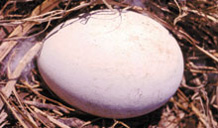
Bald Eagle eggs are six to eight centimetres in length / G.K. Peck
DDT and its breakdown product, DDE (dichlorodiphenyldichloroethyene), which is created when DDT degrades over time, affect eggshell development. The chemicals interfere with the deposition of calcium, a key component in the formation of eggshells. Eagles in the Great Lakes region – and some other birds – produced thin-shelled eggs that broke easily during incubation, killing the developing embryos.
Direct poisoning by DDT and DDE, as well as other toxic compounds, caused the deaths of some adults and hatchlings. As well, these contaminants tended to accumulate in the eggs’ fatty yolk, which contains the nutrients that sustain development of embryonic birds. As the embryos grew inside the eggs, they absorbed contaminants, along with nutrients, from the yolk.
Canada and the United States restricted the use of DDT in the early 1970s. Even so, nearly 10 years later, persistent contaminants caused Bald Eagles along the shorelines of the Great Lakes to experience total reproductive failure. For instance, few active nests remained on the north shore of Lake Erie and research showed exceedingly high levels of contaminant residue in their eggs and the blood of eaglets.
By the late 1980s, however, positive progress was emerging. DDE levels decreased by more than 50 per cent. Levels of PCBs, or polychlorinated biphenyls, decreased by as much as 80 per cent. The resulting reduction in contaminants in Bald Eagle eggs allowed reproductive rates to recover steadily. The number of active nests increased and the number of eaglets produced per nest improved. This progress was augmented by eaglet re-introduction programs, which supplemented the natural recruitment of young eagles into the population.
The sensitivity of Bald Eagles to toxic chemicals has led scientists and conservation groups to identify the birds as a bio-sentinel species, meaning that the health of eagles can be taken as a reliable indicator of the health of aquatic ecosystems in the Great Lakes region.
|
|
Bioaccumulation in the Aquatic Food Web
Chemical contaminants that degrade the health of animals can be picked up in two ways. The animals can eat the toxic substances directly while foraging for food, or they can eat other animals and plants that have absorbed the substances. The uptake of persistent contaminants from the water, sediment on the lake bottom, and food sources is called bioaccumulation. Over time, as contaminants are distributed throughout the aquatic food web, they affect every living creature.
Many chemical substances do not break down readily and accumulate in the animals’ bodies. In the Great Lakes, the main persistent industrial chemicals that affected Bald Eagles include DDT and its breakdown product DDE, polychlorinated biphenyls, and dieldrin.
It can happen like this: A chemical pollutant is released and disperses into the water and the sediment on the lake bottom. As microscopic aquatic plants and animals, called zooplankton, absorb water and nutrients, they also draw up the chemical. Because the chemical does not biodegrade, they carry the toxic burden as long as they live.
Very small organisms are at the bottom of the food web. As larger organisms eat the smaller organisms, the accumulated chemicals move into each animal’s body. Fish and other animals eat the plants, tiny organisms, and small fish, and the chemical moves into their bodies. When fish-eating mammals and birds then eat the fish, the larger animals take on an accumulated contaminant burden.
Through this process, called biomagnification, animals accumulate contaminant residues in higher concentrations than those found in the organisms they consume. Bald Eagles, similar to humans in this way, feed at the top of the Great Lakes aquatic food web and therefore, when they eat fish or fish-eating aquatic birds, they consume the greatest accumulated burden of the chemical. This load builds up in their bodies throughout their lives.
|
|
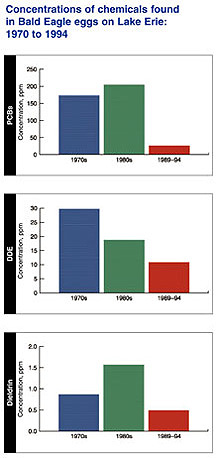
Source: Donaldson, GM, JL Shutt, P Hunter. 1999. Organochlorine
contamination in Bald Eagle eggs and nestlings from the Canadian
Great Lakes.
Notes:
1. Only eggs that fail to hatch are recovered for chemical analysis. Since the Bald Eagle is protected as an endangered species in Ontario, it is not feasible to collect eggs for routine monitoring of contaminant levels.
2. Data for the 1970s are from three eggs. The 1980 data are also from three eggs. Six eggs were used in the 1989 to 1994 data.
|
|
|
|

 Legislative Protection for Bald Eagles Legislative Protection for Bald Eagles

|
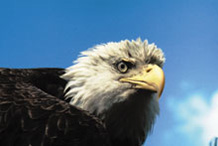
Bald Eagles can fly easily at
50 kilometres per hour / G.K. Peck
Bald Eagles first came under the wing of specific protective legislation in 1940 with the edict of the United States Bald Eagle Act. The Act, together with Ontario’s Game and Fish Act, helped to protect eagles from direct persecution. However, over the next 30 years, the effects of persistent chemical contaminants presented an unprecedented threat, particularly in heavily settled areas like the Great Lakes region.
|
|
In the early 1970s, faced with overwhelming scientific evidence, Canada and the United States restricted the use of DDT and tightened regulations for disposing of industrial chemicals. These actions, together with the development of endangered species legislation and assessment programs to monitor the status of endangered wildlife, protected the animals themselves and the habitat they need to survive. Ontario passed its Endangered Species Act in 1973.
Committees for the assessment of the status of species use a scientific approach to evaluate animal populations believed to be at risk. They also recommend recovery plans to protect and augment the populations. Each assessment is reviewed periodically and either re-instated or changed, depending on the status of the species.
In the United States, Bald Eagles are listed nationally as “Threatened” in the lower 48 states. The U.S. Fish and Wildlife Service is reviewing a proposal to change the designation. Without a protective designation, however, measures are needed to continue protection of the birds’ nesting sites.
Canada’s national assessment body, the Committee on the Status of Endangered Wildlife in Canada, is known as COSEWIC. This group made its first designations in 1978. COSEWIC consists of distinguished scientists and wildlife managers from government and non-government positions, representing 20 member agencies. All provincial and territorial government wildlife agencies are represented, as well as four federal agencies: Canadian Wildlife Service, Parks Canada, Fisheries and Oceans, and the Canadian Museum of Nature.
Bald Eagles were considered “Endangered” at the national level from 1978 to 1984, when COSEWIC changed the designation to “Not at Risk Nationally”. The more recent designation recognized the flourishing populations of eagles along Canada’s west coast and in the northern boreal forests.
At the provincial level, Ontario continues to designate Bald Eagles as “Endangered” and protects the birds and their nest sites under the provincial Endangered Species Act, proclaimed in 1973. Currently, the province is reviewing this status in response to recent improvements in the Great Lakes population and the presence of apparently healthy populations on inland lakes.
|
|
Terminology used for species at risk of extinction *
Species – Any indigenous species, subspecies, variety, or geographically defined population of wild fauna and flora.
Extinct – A species that no longer exists.
Extirpated – A species that no longer exists in the wild in Canada, but occurs elsewhere.
Endangered – A species facing imminent extirpation or extinction.
Threatened – A species that is likely to become endangered if limiting factors are not reversed.
Special concern – A species of special concern because of characteristics that make it particularly sensitive to human activities or natural events.
Not At Risk – A species that has been evaluated and found to be not at risk.
Data Deficient – A species for which there is insufficient scientific information to support status designation.
* Source: COSEWIC Terms and Risk Categories www.cosewic.gc.ca *
|
|
|
|

 Conservation Strategies and Current Conditions for Great Lakes Bald Eagles Conservation Strategies and Current Conditions for Great Lakes Bald Eagles

|
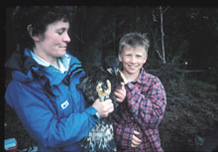
Volunteers band young eaglets
for future identification / Canadian Wildlife Service
Wildlife researchers in Canada and the United States began to study Bald Eagle populations around the Great Lakes in the 1960s. Programs were initiated to monitor chemical contaminant levels throughout the Great Lakes Basin during this era. By the early 1980s, actions were underway to promote the recovery of the Bald Eagles. These included public education, protection strategies, monitoring active territories and nest sites, building nest platforms, and monitoring eaglets in the nest. Eaglets were studied through annual counts, banding for future identification, and ongoing monitoring for contaminant levels in the blood of eaglets and in unhatched eggs.
The Southern Ontario Bald Eagle Monitoring Project, which continues today, is a joint effort between the Canadian Wildlife Service, Ontario Ministry of Natural Resources, Bird Studies Canada, community organizations, and volunteer nest monitors and landowners. Dedicated volunteers provide invaluable data and energy to the project, year after year.
Biologists from the Canadian Wildlife Service, a federal wildlife agency, and the Ontario Ministry of Natural Resources, a provincial body, joined with volunteers and landowners to monitor Bald Eagles on the Canadian side of Lake Erie, Lake St. Clair, Lake Huron and Lake Ontario. Bird Studies Canada, a non-government organization, joined the project in 1996 and now helps co-ordinate monitoring activities.
The encouraging recovery of Bald Eagle populations in the Great Lakes region could not have happened without the tremendous support of private individuals. The studies and monitoring activities rely on volunteers who record the status of Bald Eagle nests each breeding season, and the landowners who allow access to nest sites on their private property.
|
|
Monitoring population health around the Great Lakes region
From 1983 forward, during breeding season, biologists and volunteers counted, weighed, measured and banded the eaglets in each known nest in the study areas in Southern Ontario. Beginning in 1990, blood and breast feather samples were taken from the eaglets for toxicological analysis, to record concentrations of heavy metals and contaminants. These annual studies confirmed increasing numbers of active nests, and demonstrated improving population health.
Ongoing positive health results and apparent stabilization of chemical compounds led to a simplified nest and productivity monitoring protocol, beginning in 2000. It was determined that toxicological analysis of eaglet tissue samples was no longer required on a yearly basis, and the nests could be monitored by ground and aerial observation. Still, the research and monitoring team plans to monitor the contaminant situation in young eagles at five-year intervals, to ensure continued positive progress.
Release of eaglets in the Great Lakes region
From 1983 to 1987, the Canadian Wildlife Service and Ontario Ministry of Natural Resources co-operated to release healthy eaglets near Lake Erie. The intention was to augment the Bald Eagle population on the Erie lakeshore and assist in its recovery.
Eaglets were transplanted from the healthy population on the shores of Lake of the Woods in northwestern Ontario, and released on the north shore of Lake Erie. Over the four-year span of the project, 32 eaglets were released at the Long Point National Wildlife Area and the Taquanyah Nature Centre and Conservation Area, near Cayuga.
|
|
|
|

 Current Conditions and Nesting Results for Bald Eagles Current Conditions and Nesting Results for Bald Eagles

|
| Regional nesting results for 2000
Lake Nipigon and Lake Superior
Eagles along the shoreline of Lake Nipigon and the Canadian portion of Lake Superior are not monitored regularly. The population of breeding Bald Eagles is considered stable to increasing. There are 23 known active nests on Lake Superior. On Lake Nipigon, including the Nipigon River below the Alexander Dam, there are 81 active nests. In both Canada and the United States, inland populations are larger than those on the shores, possibly due to richer foraging opportunities, or because there is more inland habitat for eagles than there is suitable Great Lakes shoreline habitat.
Lake Erie, Lake St. Clair and Detroit River
The north shore of Lake Erie produced 21 young birds, fledged from 14 nests. Bald Eagles are also doing well on the south shore in Ohio. A record 63 nests hatched 89 young birds. Lake St. Clair and the Detroit River each had one successful nest in 2000.
Lake Ontario
No Bald Eagles have nested on the north shore of Lake Ontario since the late 1950s. However, successful nests were found in 2000 in Frontenac and Northumberland Counties, just north of the lake. Also, for the first time since recovery efforts began in the 1970s, a pair of Bald Eagles fledged one young bird on the south shore of Lake Ontario in New York state.
St. Lawrence River
For the first time in several decades, one successful nest was discovered in 1999 on the St. Lawrence River in Leeds-Grenville County.
Lake Huron
There are at least 10 known active nests on the Canadian shores of Lake Huron.
|
|
|
Although concentrations of DDE and PCBs have declined markedly since the 1970s, these two compounds continue to contaminate the aquatic ecosystems of the Great Lakes. Current levels of DDE analyzed from blood samples from nestling Bald Eagles are fairly uniform across the region, whether taken from birds on Lake Erie, Lake Huron, Lake Nipigon, Lake Superior or Lake of the Woods. The similar levels may be the consequence of several factors, including the dispersal behaviour of prey species like fish, gulls and waterfowl, the migratory behaviour of the eagles, and the natural flow of contaminants through the Great Lakes.
An example of a combination of these possibilities is the occurrence of mirex in blood samples from nestlings on Lake Superior. Mirex, a chemical used as a pesticide and flame retardant, was manufactured on the Niagara and Oswego Rivers, which flow into Lake Ontario. The appearance of this compound in the nestlings indicates that Bald Eagles nesting on Lake Superior may winter on Lake Ontario and accumulate mirex in their bodies, or they may eat birds that have fed on mirex-contaminated fish and then moved to Lake Superior
For four consecutive years, from 1996 to 2000, Bald Eagles in southern Ontario have produced about 1.3 young per active nest, more than enough to maintain the population. Also, new eagle territories were established in areas that have not been occupied since the late 1970s.
Overall, southern Ontario Bald Eagles hatched and fledged healthy young birds at a 90 per cent success rate, including several nests that produced three young birds.
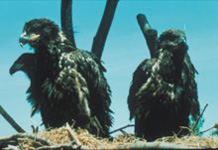
Eaglets look out from the nest
high in a tree / Marshall Field and Douglas Baird |
| |
|
|
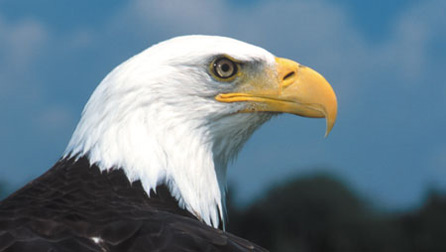 Habitat quality remains a serious concern / John Mitchell
Habitat quality remains a serious concern / John Mitchell
|
|
|
|

 Bald Eagles Today and Tomorrow: Asking the Difficult Questions Bald Eagles Today and Tomorrow: Asking the Difficult Questions

|
|
Over the last two decades, the population of Bald Eagles in the Great Lakes region has been on the rise. Productivity trends, closely monitored since the early 1980s, indicate that reproductive rates are sufficient for population growth. The eagle population’s overall health is improving.
Studies demonstrate that eaglets hatched today carry a less significant burden of toxic chemical concentrations than 25 years ago. In 2000, Bald Eagle pairs were able to fledge their young at a 90 per cent success rate. Still, with all of this good news, an unresolved question remains: Is the Great Lakes Bald Eagle population truly self-sustaining?
Significant problems affecting the health of local aquatic ecosystems may interfere with the long-term success of the eagles. Concerns that are not yet alleviated include: the progressive loss of suitable habitat for nesting and feeding; high turnover rates of breeding birds; the potential damage from long-term exposure to persistent organic contaminants and possible harmful effects of exposure to heavy metals.
What is causing the high turnover of breeding birds?
Bald Eagle pairs generally return to the same breeding territory, and often the same nest, every year. Recently, turnover rates were calculated for eight nests in southwestern Ontario. The nests in the study were occupied for an average of 11 years before one or both of the breeding birds were replaced. While this may sound like a long time, a population of healthy adults would not be expected to have such a rapid nest occupancy turnover rate.
One result of the study that warrants particular concern is the age of the replacement birds. Four of the 11 observed turnovers involved replacement birds that were juveniles, or “sub-adults”. The opportunity for juvenile birds to breed may indicate that there are not enough breeding age birds in the population. Inexperienced breeders may be less successful in fledging their young, which, over time, would have a significant negative affect on the population. Mortality rates are high for young eagles, even in healthy populations.
Are eagle populations at risk from long-term exposure to persistent organic contaminants?
The health of the Great Lakes ecosystems has improved remarkably since the 1970s. The presence of organic contaminants, however, persists at low levels and continually circulates within the aquatic food web. The effects of long-term exposure to these chemicals may remain detrimental to the health of Great Lakes eagles.
Environmental factors may place considerable stresses on the birds, causing them to be more vulnerable to contaminants. Severe weather swings may result in lower reproductive success. Or poor food availability and quality may cause eagles to be more susceptible to contaminant-related effects. Environmental smog may play a role. The Great Lakes Bald Eagle community has been slow to recover in comparison to continental North America. Contributing factors may include the geographic location, the weather – including heat, drought and smog – and atmospheric pollution.
Even while researchers observe improved hatching rates for active nests, in some regions they also find developmental deformities in eagle nestlings. These deformities include beak and foot malformations, fused vertebrae and hip displacements. While exposure to PCBs and other toxic compounds is confirmed, the cause or causes of these deformities is not determined.
|
|
What are the possible harmful
effects of exposure to heavy metals?
Food is the primary vehicle that moves contaminants, including heavy metals, into eagles’ bodies. In the 1970s, mercury and lead were considered contributors to the decline of Bald Eagle populations. However, research at that time failed to demonstrate a cause and effect relationship between exposure to heavy metals and population decline.
The effects of exposure to mercury, in particular, are a serious concern because of its widespread distribution, and its potential for chronic effects. Toxic at very low concentrations, mercury can accumulate in the body’s tissues.
Mercury is a naturally occurring element that is virtually ubiquitous in the environment. Also, it is released into the atmosphere through naturally occurring and manufacturing processes. Human-made sources of mercury include mining and smelting, pulp and paper production, burning of fossil fuels and wood, petroleum refining, and solid-waste incineration. An estimated two-thirds of the mercury in the atmosphere originates from these sources.
Ultimately, mercury in the atmosphere deposits on the earth and makes its way into aquatic systems. The discovery of mercury-contaminated fish in relatively undisturbed Canadian lakes was one of the first clues that acid rain may be an indirect conduit of mercury. Consumption of fish that is contaminated with mercury is known to be hazardous to wildlife and human health. In large doses, it will impair neurological function and complex behaviour.
Since 1997, biologists in Ontario examined ailing and dead Bald Eagles, and found elevated levels of mercury and lead in their bodies. Preliminary results suggest that the accumulated amounts may have been detrimental to their health. Since heavy metals do not bind to fatty egg yolks in the way DDT does, there is little transfer from the female bird to her eggs. Hence, any accumulated burden could have been the result of a diet of contaminated food. Since birds that consume heavy metals increase their burden as they age, heavy metals can diminish their life expectancy.
Determining whether mercury exposure is a long-term problem that is responsible for reducing longevity, and hence breeding potential, of Bald Eagles in Ontario, is one of the next questions that the Bald Eagle recovery team would like to explore. Anything that reduces adult longevity and long-term productivity to a notable degree has the potential to result in population decline – even if short-term population growth appears to be sufficient to sustain the species.
Is there adequate habitat available for a robust Bald Eagle population?
Habitat is defined as the food, water, shelter and space that an animal requires to survive. The availability of suitable habitat plays a critical role in regulating animal populations. Bald Eagles prefer forested, quiet sites near open water within a territory of one to three square kilometres, nesting in one of the tallest, mature trees in the area. But forest harvest and lakeshore development for agriculture, residences and recreation continue to deplete and degrade appropriate shoreline habitat.
Yet, eagles can demonstrate remarkable adaptability in the face of habitat pressures, nesting in locations that are subject to human disturbance or provide poor food supplies. For example, Bald Eagles have been observed nesting on the tower at Sandusky Airport in Ohio.
It is not yet clear whether nesting in such atypical sites, with their related hazards for adult and juvenile birds, will have a negative long-term effect on the overall population. The unanswered question is whether the birds’ adaptation to human interference and low quality nesting habitat will deplete or negatively influence the population.
|
|
|

 Acknowledgements Acknowledgements
 |
|
The story of the Great Lakes Bald Eagles could not be told without acknowledging the valuable assistance of the countless volunteers who give their time to monitor Bald Eagle nesting sites, as well as the landowners who allow access to their properties for ongoing study of the birds and, most importantly, protect the nests from harm or disturbance.
Environment Canada would like to thank those who generously shared their expertise in the development of this fact sheet: Pud Hunter of the Ontario Ministry of Natural Resources, and Jon McCracken and Debbie Badzinski of Bird Studies Canada. Mention must be made also of Bill Bowerman of Clemson University in South Carolina, and Mark Shieldcastle of the Ohio Department of Natural Resources.
Environment Canada, Ontario Ministry of Natural Resources, Bird Studies Canada and Ontario Power Generation provided support for the production of this fact sheet.
|
|

Installing a Bald Eagle nest platform / Ontario Ministry of
Natural Resources
|
|
  
|

Bald Eagles lay their eggs in an enormous nest
constructed of branches high in a tree / G.K. Peck
|
|

 About
the Canadian Wildlife Service About
the Canadian Wildlife Service |
| |
The Canadian Wildlife Service, part of
Environment Canada, manages wildlife matters that are the responsibility
of the federal government. These include protection and management
of migratory birds, nationally significant habitat and endangered
species, as well as work on other wildlife issues of national and
international importance. In addition, the Canadian Wildlife Service
does research in many fields of wildlife biology. In 1997, the Canadian
Wildlife Service (formerly Dominion Wildlife Service) celebrated its
fiftieth year as a federal agency responsible for conserving Canadian
wildlife. |
|
|
|
Contacts
|
 |
 |
 |
 |
 |
Environment Canada
Environmental Conservation Branch, Ontario Region
Canadian Wildlife Service
4905 Dufferin Street
Downsview, Ontario M3H 5T4
Tel: 416 739-5830
Website: www.on.ec.gc.ca/wildlife |
|
Ontario Ministry of Natural Resources
Toronto
General Inquiry
416 314-2000
French Inquiry
416 314-1665
Peterborough
General Inquiry
705 755-2000
Website: www.mnr.gov.on.ca * |
|
Bird Studies Canada
P.O. Box 160
Port Rowan, Ontario N0E 1M0
Tel: 1 888 448-BIRD
Website:
www.bsc-eoc.org * |
|
|
|
Educators' Reference
|
|
Great Lakes Fact Sheets |
General Educational
Themes
Bald Eagles in Ontario
Bioaccumulation in the Aquatic Food Web
Biology and Wildlife
Chemical Contaminants in the Great Lakes
Conservation Strategies for Bald Eagles in Ontario
Endangered Species in Ontario
Habitats and Communities
Human-Environment Interactions
Interactions Within Ecosystems
Legislative Protection for Endangered Species
Water Systems
Ontario Curriculum Links
Science, Grade 10, Academic – The Sustainability
of Ecosystems
Bioaccumulation; survival and
equilibrium of populations in
an ecosystem; dynamic nature of ecosystems; ecological balance
and the sustainability of life; ecological systems and the consequences
of changes in these factors.
Science, Grade 10, Applied - Ecosystems and Human
Activity
Bioaccumulation; ecological balance
and the sustainability of life; natural and human threats to
a local ecosystem; environmental sustainability with a particular
focus on issues in Ontario and Canada.
This
Great Lakes Fact Sheet is available in PDF format.
|
|
The Great Lakes Fact Sheet series
is available on-line at the following URL: www.on.ec.gc.ca.
All publications are available in both HTML and PDF format,
for the purposes of accessibility and convenience.
To order printed copies of this or any other Great Lakes Fact
Sheet, contact:
Environment
Canada
Canadian Wildlife Service
4905
Dufferin Street
Downsview, Ontario M3H 5T4
Tel: 416 739-5830
Fax: 416 739-5845
E-mail: Wildlife.Ontario@ec.gc.ca
This fact sheet was printed
on acid-free paper, containing 30 per cent post-consumer recycled
waste, and printed with vegetable-based inks.
Published by Authority of the Minister of the Environment
© Minister of Public Works and Government Services Canada,
2001
Prepared by: A.L. Neilson and Julie Suzanne Pollock
Catalogue No. En XX CW69-17/1-2001E
ISBN 0-662-29808-X
Aussi disponible en français. |
|
|
